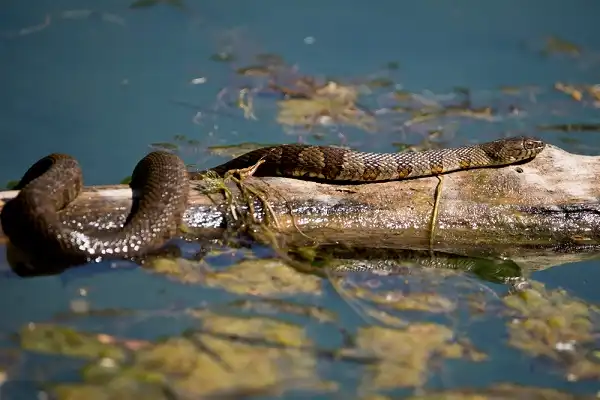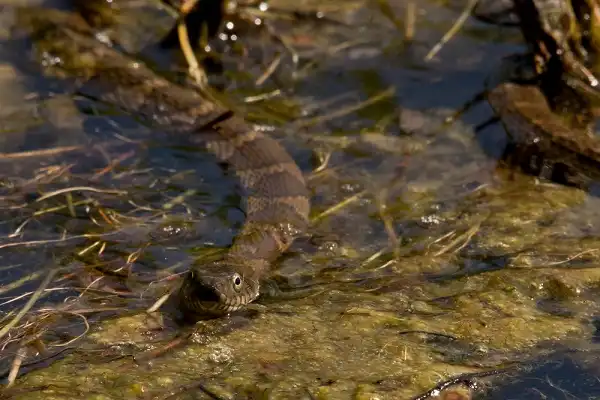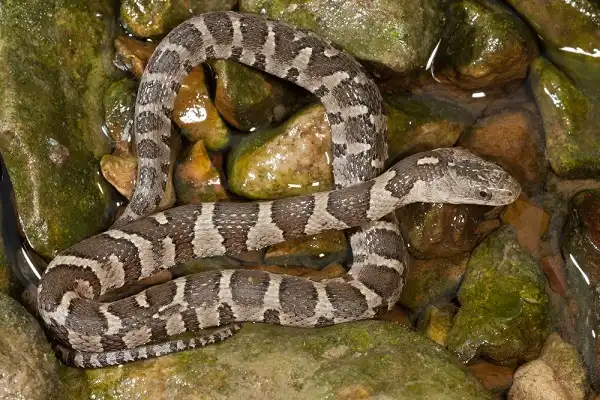Are you interested in learning more about the amazing amphibians found in northern climates? Then it’s time to introduce you to one of nature’s most fascinating creatures – the Northern Water Snake! This species is known for its vibrant colors, vividly patterned skin, and its ability to swim like a fish. It can be found slithering through lakes, streams, and rivers throughout Canada and parts of the United States. Join us on this journey as we explore these carefully adapted animals’ unique characteristics and what makes them so special!

Northern Water Snake Description
The Northern Water Snake, scientifically known as Nerodia sipedon, is a non-venomous reptile that belongs to the pitviper family. Their sleek, slender bodies are typically brown or gray with dark-brown or reddish-black crossbands that become wider near the belly. These markings help camouflage them in their aquatic environment, making them difficult to spot by predators and prey. These reptiles are mostly active during the day, and their mating season usually runs from April to June. They are ovoviviparous, meaning that the eggs hatch inside the female’s body, and they give birth to live young in late summer. A female snake can give birth to up to 30 babies.
Northern Water Snake Habitat
The Northern Water Snake is a highly adaptable species that can be found in a variety of aquatic habitats throughout North America. They prefer freshwater environments that provide ample prey and shelter, such as slow-moving streams, rivers, and lakes, as well as marshes, swamps, and other wetlands. These snakes are found throughout much of Canada, as well as in the eastern and central United States, from Florida to Minnesota. They are particularly abundant in the Great Lakes region, where they can be found in large numbers in and around the water. The Northern Water Snake is a resilient creature that can tolerate a range of water temperatures, from cold, northern lakes to the warm, southern waters of the Gulf of Mexico. They are also able to survive in habitats with low oxygen levels or high levels of pollutants, making them a true survivor in an ever-changing environment. Despite their ability to adapt to various conditions, the population of Northern Water Snakes is starting to decline due to habitat destruction and pollution. Wetland destruction, urbanization, and agriculture are some of the biggest threats to this species, which relies on clean water and undisturbed habitats to survive.
Northern Water Snake Diet
The Northern Water Snake is a carnivorous predator that possesses a slender and agile body adapted for its aquatic lifestyle. This aquatic species consume a wide range of prey, including fish, frogs, salamanders, and crayfish. In some instances, they have also been observed eating small birds and rodents. Their hunting tactics involve sneaking up on their prey and then rapidly latching onto it with their jaws. Their long and muscular body enables them to constrict their victim, restraining its movements before swallowing it whole. Northern Water Snakes possess a specialized tongue equipped with a highly developed sense of smell, which enables them to detect the scent of potential prey even when submerged underwater. The Northern Water Snake is a versatile predator that feeds on a range of aquatic prey, including fish, frogs, salamanders, and crayfish. Their hunting tactics involve constriction, and their tongue is highly adapted to detect the scent and heartbeat of their prey. Despite their predatory nature, Northern Water Snakes are a vital part of the ecosystem, maintaining a delicate balance between predator and prey.

Northern Water Snake Size
The Northern Water Snake is a medium-sized species of snake, with adults reaching an average length of 2-4 feet. However, some individuals have been known to grow up to 5 feet in length. They are typically slender and muscular, with rough scales and a flattened head that is wider than their neck. Their body is colored in a wide range of patterns, from solid brown to gray with blotches and stripes of darker colors. Interestingly, the Northern Water Snake is one of the few snake species that exhibit sexual dimorphism, with females being larger and thicker than males. Female Northern Water Snakes have been recorded reaching lengths of up to 6 feet. Like most snakes, the Northern Water Snake undergoes periodic molting, shedding their old skin to reveal a new, vibrant one beneath. Younger snakes shed their skin more frequently than older ones, with some individuals molting as often as once a month during their first year of life.
Northern Water Snake Lifespan
The Northern Water Snake is a long-lived species that can survive for up to 10 years in the wild. However, some individuals have been known to reach the ages of 12 years or more under ideal conditions. The lifespan of Northern Water Snakes varies depending on several factors, including their environment, diet, and genetics. Like other reptiles, Northern Water Snakes grow throughout their lives, with their rate of growth slowing down as they reach maturity. During their early years, Northern Water Snakes are particularly vulnerable to predation, and their survival rate is relatively low. However, those that do survive their first few years can expect to live a relatively long and healthy life. One of the factors that contribute to the longevity of Northern Water Snakes is their adaptable nature. They are a remarkably hardy species that can tolerate a wide range of environmental conditions, including changes in temperature and humidity levels. Another factor that contributes to the longevity of Northern Water Snakes is their specialized diet.
Northern Water Snake Behavior
Northern Water Snakes are fascinating creatures with a range of intriguing behaviors. They are primarily diurnal, meaning they are active during the day, and spend much of their time basking on rocks or other sun-warmed surfaces. They are also excellent swimmers and can be found both in and out of the water. One of the most notable behaviors of the Northern Water Snake is its unique defense mechanism. When threatened, they will often release a foul-smelling musk from their cloaca, a scent that is both unpleasant and potentially dangerous to predators. In addition, Northern Water Snakes are known to flatten their bodies and elevate their heads and tails in a twisting motion, making themselves appear larger and more intimidating to potential threats. Northern Water Snakes are also social creatures and can often be found living in groups, particularly during the breeding season. Overall, the behavior of the Northern Water Snake is a testament to its remarkable adaptability and ability to thrive in a range of environments. Their unique defense mechanisms, social habits, and hunting strategies are all indicative of a species that has evolved to survive and thrive in its surroundings. By studying and understanding these behaviors, we can continue to protect and conserve these remarkable creatures for generations to come.

Northern Water Snake Speed
The Northern Water Snake is not only adaptable, social, and an agile predator, but it is also surprisingly fast. Despite its sleek and streamlined body, which is built for swimming and maneuvering through aquatic environments, the Northern Water Snake can reach impressive speeds on land as well. When escaping a threat or pursuing prey, the Northern Water Snake can move at speeds of up to 4 miles per hour, an impressive feat for a creature its size. They achieve this speed by using their muscular body to undulate in a wave-like motion, propelling themselves forward in a quick and efficient manner. What’s more, the Northern Water Snake has been known to use this speed to its advantage in surprising ways. For example, during the breeding season, males will compete fiercely for the opportunity to mate with a female. In some cases, a male will chase a female through the water and onto land in a bid to win her over.
Northern Water Snake Hunting
When it comes to hunting, the Northern Water Snake is a highly skilled predator, with a range of impressive physical adaptations and strategies that enable it to catch a wide variety of prey. Their hunting abilities are essential for their survival, as they rely on their diet of fish, amphibians, and small mammals to sustain their energy and growth. One of the Northern Water Snake’s most notable physical adaptations for hunting is its sharp eyesight and keen sense of smell. This allows them to detect potential prey both in and out of the water, making them highly efficient hunters in a range of environments. Once a potential target has been located, the Northern Water Snake will use its muscular body to propel itself toward the prey with great speed and precision, often striking with lightning-fast speed. Another key strategy employed by Northern Water Snakes during hunting is their ability to stalk their prey from the water. They are highly efficient swimmers, with their sleek and streamlined bodies allowing them to move through the water with remarkable speed and agility. This allows them to survey their surroundings and identify potential prey, before launching a sudden strike with their sharp teeth and powerful jaws.
Northern Water Snake Reproduction
Understanding the Northern Water Snake’s reproductive behaviors is also important, as it helps us better understand and protect their populations. During the Spring and Summer months, females will deposit between 15-50 eggs in mud or sandy soil on shorelines to increase their chances of survival. The eggs can take up to 2 months to hatch and once they do, the young snakes are immediately left on their own to fend for themselves against potential predators. This fascinating process often occurs during periods of high water levels, when nearby lakes and rivers provide an ideal habitat for these small reptiles. By understanding the Northern Water Snake’s reproductive behavior we can continue our efforts to ensure their protection and longevity in the wild.

Northern Water Snake Predators
While the Northern Water Snake is a formidable predator itself, it still faces a range of threats from its predators. These include birds of prey such as hawks and owls, large fish species like bass and walleye, and mammals such as raccoons and river otters. To protect themselves from potential predators, Northern Water Snakes have adopted a variety of defense mechanisms including secreting a pungent odor from their skin and thrashing around wildly when disturbed. While these strategies can be effective in deterring some predators, they are no match for larger animals that prey on this species. To ensure their protection in the wild, human intervention, and conservation efforts are essential to preserving the Northern Water Snake’s place in the ecosystem.
Conclusion
The Northern Water Snake is an awe-inspiring creature that is capable of impressive feats of speed and agility. With their sharp eyesight, keen sense of smell, and powerful swimming abilities, they are highly skilled predators that rely on their hunting capabilities to sustain themselves in the wild. In conclusion, the Northern Water Snake’s hunting behavior is a testament to its remarkable adaptability and effectiveness as a predator. Their combination of raw physical power, acute senses, and unique defense mechanisms make them one of the most fascinating creatures in the natural world.
Frequently Asked Question

